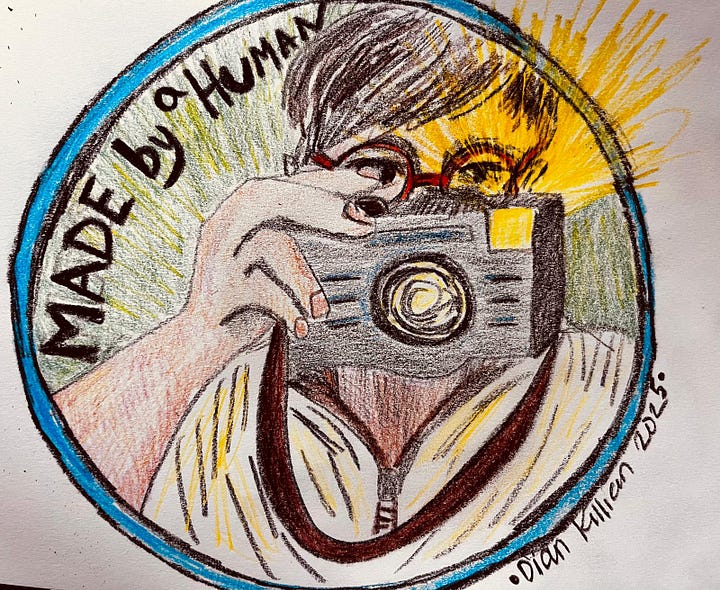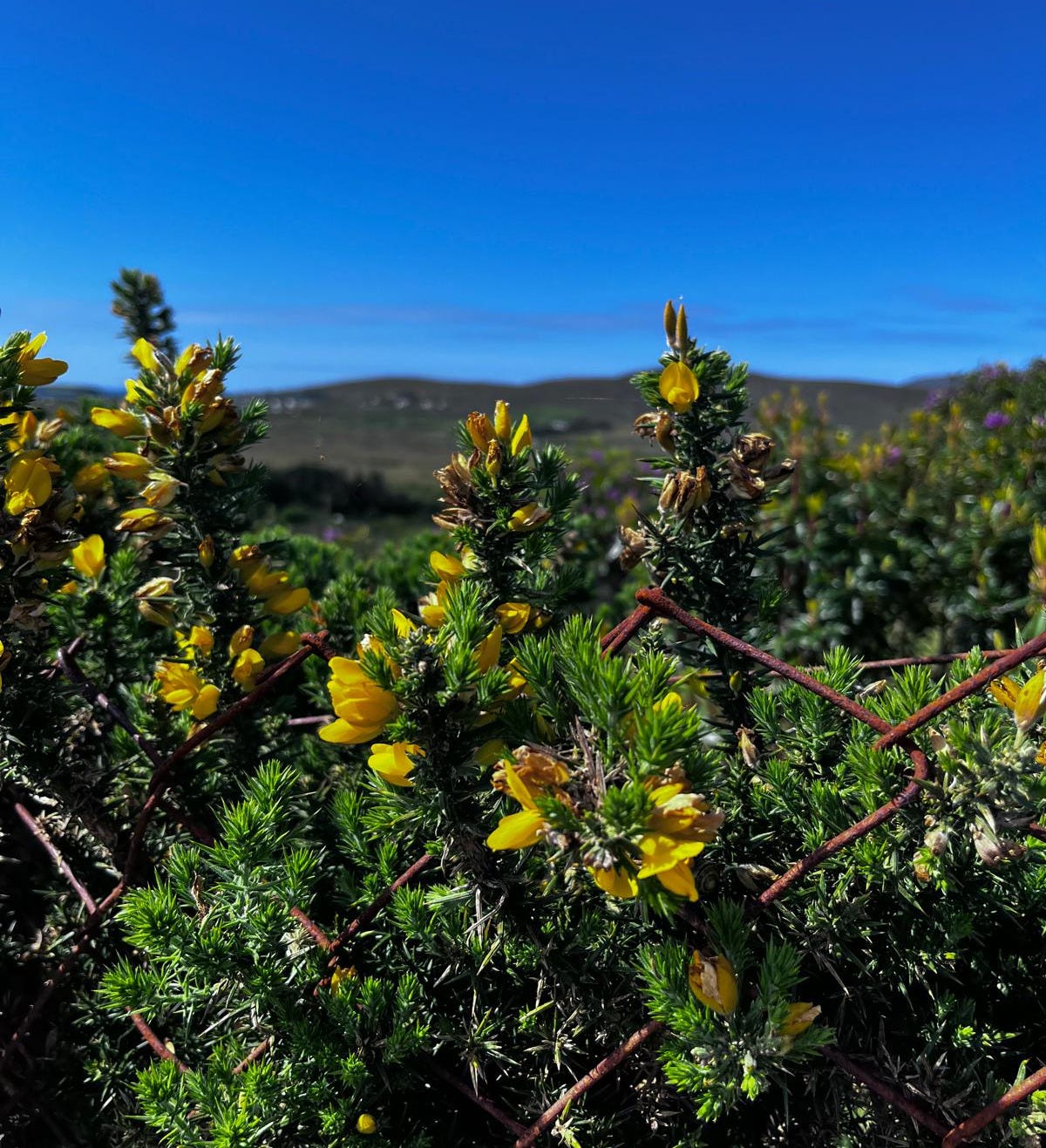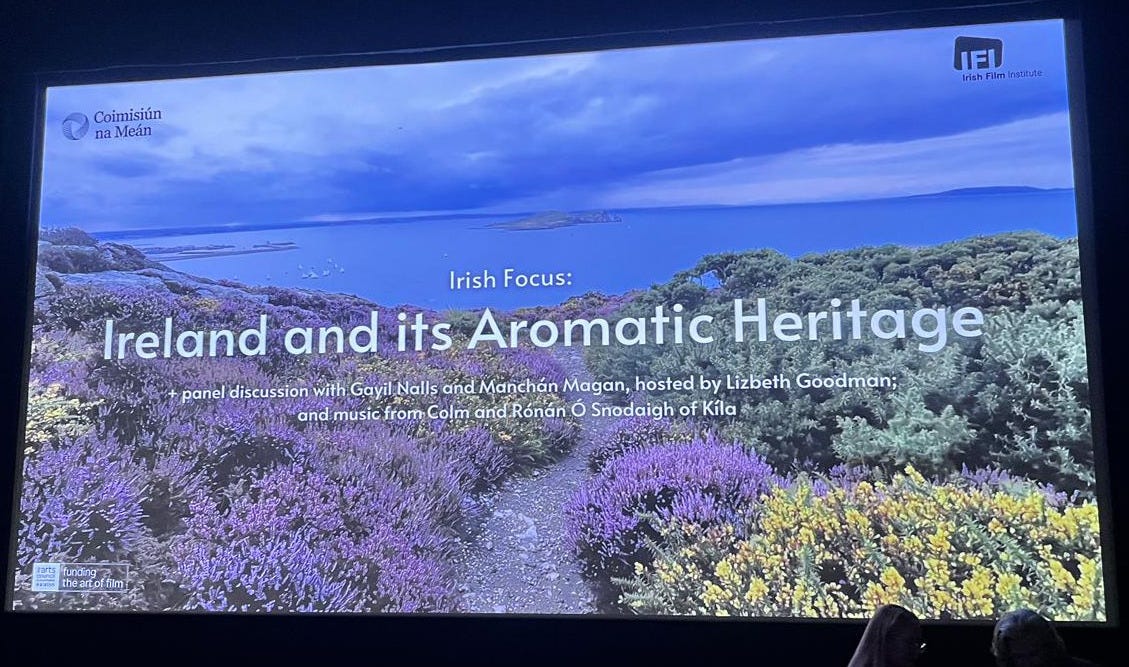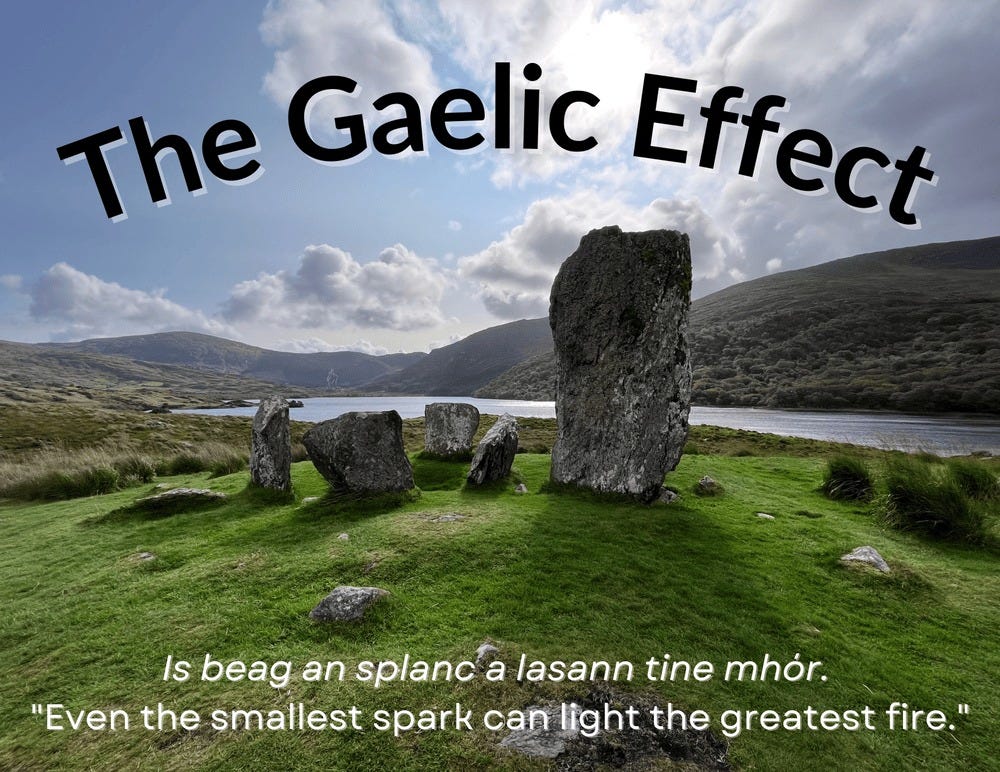First of all, I regret that I’m running a wee bit late this week—am traveling (currently in New York City) so doing this passion project on the hoof. I am glad, while in the “concrete jungle,” to be reflecting on the natural world. I hope you enjoy it too and, if you do, please “like” and share. GRMA arís —thanks again—for reading and all your support!
In honor of Beltane—when spring comes in shiny and new—the last edition of The Gaelic Effect focused on the natural world. From “God’s Little Cow” (the ladybird/bug) to miol mór (the whale, but literally, big louse), we saw with fresh eyes much that we can overlook. Today, the Beltane Fest continues with plants and flowers.
Some flower-words as Gaeilge are similar to English and even phonetic: poipín (poppy), lúipín (lupin), lile (lily), tiúilip (tulip). Some are sibling-like translations: Plúirín Sneachta is Snowdrop; plúirín can mean “flour” in Irish and “flower,” hence “snow flower.” Peirsil bhó, also known as Queen Anne’s lace, is literally “cow parsley.” Sun-flower is lus na gréine, herb or plant of the sun.
Similar to animal names, many plant names are descriptive in Irish. Daffodils are lus an chromchinn, “plant of the bent head.” Lus mín is dill—the fine, soft and tender herb (mín). Strawberries are sú talún, “juice or berry of the earth” and grapes fíonchaora, literally “wine berries.” (The Irish clearly know what to do with grapes!) I have always loved the word “buttercup” because it describes so beautifully how this flower looks —the color of melted butter (especially Irish butter!). As Gaeilge, it’s cam an ime or “melting pot of butter.”
Indigenous Irish culture clearly held appreciation for plants. Basil is Lus mic rí, herb of the king’s son. Coinneal Oíche, Evening Primrose, is the “candle of the night.” Many flower-words end with ín which is diminutive and expresses endearment. It is sweet that Bluebells is cloigín gorm, not just “bells” but “small blue bells.” Nóinin is daisy, Nóinín na gréine (golden rod) is “Daisy of the sun,” and goirmín is pansy. “Though pansies come in different colours, one of the most striking is the blue ones, hence ‘goirmín’, ‘little blue’.” (Irish) Róisín, a popular girl’s name, is “little rose.”
Speaking of respect, foxgloves, a highly poisonous plant, is called in Irish Lus na mban sídhe, the plant or herb of the fairy-woman. Bell-shaped plants do seem to invoke wonder and magic. When I was growing up, my grandmother sang:
White coral bells, upon a slender stalk. Lilly of the Valley on my garden walk. Oh how I wish that I could hear them ring! That will happen only when the fairies sing.
I never heard them ring but my grandma singing was magic in itself.
Like old friends, there are plants that especially remind me of Ireland: gorse and heather, that grow in the bogs; blackberry brambles and fuchsia, that grow in the hedgerow, and edible plants, such as nettles and wild garlic. In the spring, wild garlic with it’s small, bright white blossoms, spring up around Ireland, including Dublin. Many people, even in the capital, cook with it. I also have fond memories of picking blackberries in the capital city. In the ‘80s, when living in Kilmainham, I picked buckets of them along the back lane behind IMMA (the Irish Museum of Modern Art) and made jam. This led to a mishap with Hibernian-English. In the U.S., when I was growing up at least, we melted paraffin wax and used it to make lids on jam pots. Every grocery store that carried canning supplies would sell it. In Dublin, when I went into a shop and asked for it, I got a baffled response. When I explained that I wanted to pour it on top of my jam, the shop worker was aghast. In Ireland, “paraffin” is a liquid fuel. It would be like pouring kerosene in your jam. Here, wax paper is used for lids instead.
On Wednesday, I luckily got to attend a screening of the film, Ireland and its Aromatic Heritage, which was followed by a Q&A with the director, Gayil Nalls, and author Manchán Magan. The film is part of a larger project that Gayil has been working on for decades, the World Sensorium, a “world olfactory social sculpture.” The project “surveyed the officials of 240 countries (and territories) to identify dominant natural aromas retained through odor memory by a majority of people of each country.” A natural perfume was then made from all these identified aromas, to represent human memory and experience. (You can see the plants that people chose all around the world, here.) Nalls spoke passionately about how language and olfactory memory are inter-connected:
“The study established that highly associative natural scents work as olfactory imprints and memory triggers for large numbers of people of cultures in every region of the world.”
When the project was first conducted in Ireland about twenty years ago, the smell of burning peat was most iconic for Irish people. The film beautifully captures the importance of the bog (where peat is extracted) in Irish culture, history, family-life and memory. One of the speakers, while not specifcally using the word meitheal, describes how this traditional way of working together in Ireland continued until very recently in cutting turf. (Learn more about the meitheal here—and see a photo of traditional turf cutting). Dublin in the 1980s was still sooty—on cold days, with many stoking their fires and coal still being used, it was like a scene from a Charles Dickens novel. The city was black with coal smoke. Many people were also burning turf and for me, no other smell reminds me of Ireland more. I clearly am not the only one. I saw years ago in a tourist shop a little miniature cottage that was an incense burner; it came with turf-scented pellets that, when lit, would produce smoke rising out of the chimney of the miniture cottage. It was the smell of home—as much as a good pot of tea and fresh baked soda bread.
Now, with the burning of peat being phased out for enviornmental reasons, a new tally is being taken about which aromatic scent best represents Ireland. You can see the nominees here and, if you are Irish or are resident in Ireland, can vote on the plant that most resonates for you.
What wakes us up? What makes us fall in love with the world again? What aromatic smells do you recal, that bring you home? I hope this issue of The Gaelic Effect has inspired you, earth-ling, to remember, re-kindle, and connect.
Slán (good-by) for now, from Nua Eabhrac inniu (New York today),
Dian
You can also support The Gaelic Effect and its mission by making a one-time donation by clicking anseo (here).










Wonderful article. Dian, I really enjoyed reading this.. and others. About 8-9 months ago I began writing a short story for my grand-daughter who lives in Cincinnati when she told me wanted to come to Scotland and see the Fairy Pools on Skye (tbh they're not that impressive). What was meant to be 1,000 words on Faeries, of whom I know very little, the story has grown to 100,000 words and that is only to the end of part one. It is probably a bit too dark now for a nine year-old.
All that aside, in order to try and make my storyline and characters plausible I wanted to include Irish and Scots Gaelic names and places. I know only a few words of these and was considering giving up when I met Manchán Mangan doing his wonderful talk and performance, "Arán & Im" at the Sabhal Mor on Skye. I had no idea what I was going to see that evening and could not believe that, right.at that very moment, I wandered into that show. What were the odds?
I had a chat afterwards with Manchán, who is a lovely and interesting man, and bought a couple of his books through which I have since fallen in love with my old heritage language and have begun to learn it, albeit slowly. It is a beautiful language. It is through Manchán that I found SubStack.
My story is likely a pile of doo-doo and I have probably got a lot of stuff wrong, but I had so much fun writing it and especially enjoyed working to include little bits of Irish in speech, names and places; I also had to research a little on plants for my ancient society's health and healing. So, that is why, he says, finally, I really enjoy your articles.
Dian, I really enjoyed this piece. I don't speak Irish at all, but I was able to recognise some of the words, like the name for foxglove. Just wonderful stuff that you share here! And that screening and Q&A sound fascinating too. I spend much of my free time in the Mourne Mountains and it is the smell of gorse on a summer's evening that tethers me to this place like nothing else.